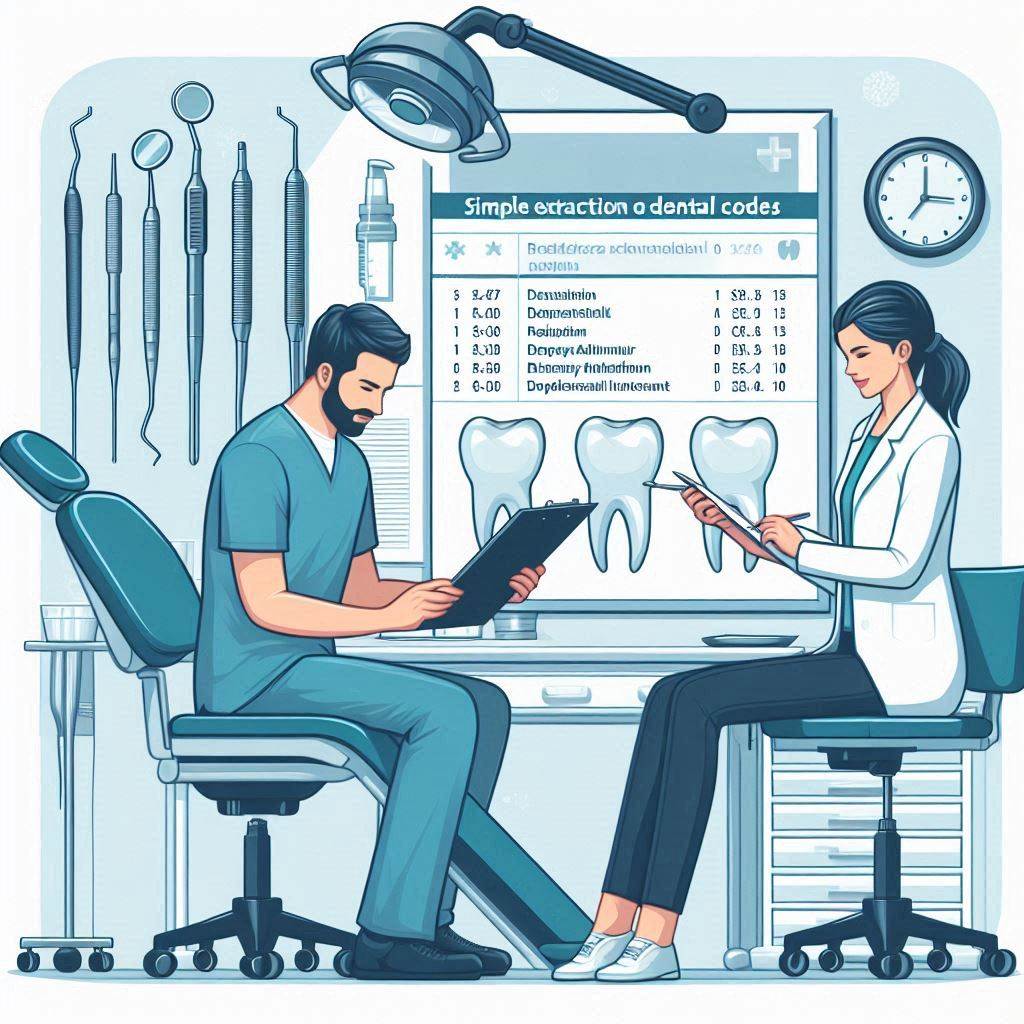Simple Extraction Dental Codes
A simple tooth extraction is one of the most common dental procedures performed worldwide. Unlike surgical extractions, which involve complex removal of impacted or broken teeth, simple extractions are performed on teeth that are fully erupted and visible in the mouth. Dentists use specialized instruments to loosen and remove the tooth with minimal trauma to surrounding tissues.
This procedure is typically coded under D7140 (extraction of an erupted tooth) in the American Dental Association (ADA) Current Dental Terminology (CDT) coding system. Understanding the correct billing codes, procedural steps, and aftercare is essential for both dental professionals and patients.

2. Understanding Dental Extraction Codes (D7140, D7210, etc.)
Dental billing relies on standardized codes to ensure accurate insurance claims and reimbursements. The most relevant codes for simple extractions include:
| Code | Description | Notes |
|---|---|---|
| D7140 | Extraction of an erupted tooth | No surgical flap needed |
| D7210 | Extraction of an erupted tooth requiring elevation of a mucoperiosteal flap | Minor surgical involvement |
| D7220 | Removal of impacted tooth – soft tissue | Partially bony impaction |
| D7230 | Removal of impacted tooth – partial bony | Fully bony impaction |
Key Takeaway:
- D7140 is the standard code for simple extractions.
- If the procedure involves minor surgical techniques (e.g., gum flap), D7210 may apply.
3. When Is a Simple Extraction Necessary?
Simple extractions are recommended for:
- Severe tooth decay that cannot be restored with a filling or crown.
- Advanced periodontal disease causing tooth mobility.
- Orthodontic reasons (e.g., overcrowding before braces).
- Fractured or non-restorable teeth.
Contraindications:
- Impacted teeth (require surgical extraction).
- Teeth with curved or fused roots.
- Patients with bleeding disorders or compromised immunity.
4. Step-by-Step Procedure for Simple Extractions
Step 1: Diagnosis and X-rays
- Dentists perform a clinical exam and take periapical or panoramic X-rays to assess tooth structure and root anatomy.
Step 2: Anesthesia Administration
- Local anesthesia (Lidocaine, Articaine) is injected near the tooth to numb the area.
Step 3: Loosening the Tooth
- An elevator is used to gently widen the tooth socket.
- Forceps are then applied to rock the tooth back and forth until it detaches.
Step 4: Extraction and Socket Cleaning
- The tooth is removed, and the socket is inspected for debris.
- Gauze is placed to control bleeding.
5. Anesthesia and Pain Management
- Local anesthesia is standard.
- Nitrous oxide (laughing gas) may be used for anxious patients.
- Post-op pain relief: Ibuprofen or acetaminophen is typically sufficient.
6. Common Challenges and Complications
- Root fracture: If a root tip breaks, it may require surgical removal.
- Dry socket (alveolar osteitis): Occurs when the blood clot dislodges, exposing bone.
- Infection: Rare but possible if aftercare instructions aren’t followed.
7. Post-Extraction Care and Recovery
- Bite on gauze for 30-60 minutes.
- Avoid smoking, straws, and vigorous rinsing for 24-48 hours.
- Soft diet recommended for the first few days.
8. Billing and Coding for Simple Extractions
- D7140 is the primary code.
- Modifiers may apply if multiple teeth are extracted.
- Insurance pre-authorization may be required.
9. Insurance Coverage and Reimbursement
- Most dental PPO plans cover 50-80% of extraction costs.
- Medicaid covers extractions for low-income patients.
10. Differences Between Simple and Surgical Extractions
| Factor | Simple Extraction | Surgical Extraction |
|---|---|---|
| Tooth Type | Erupted, visible | Impacted, broken |
| Procedure | Forceps only | Requires incision & sutures |
| Recovery Time | 3-7 days | 7-14 days |
11. Pediatric vs. Adult Simple Extractions
- Children’s teeth have shorter roots, making extractions easier.
- Adults may have denser bone, requiring more force.
12. Frequently Asked Questions (FAQs)
Q1: How long does a simple extraction take?
A: Typically 10-30 minutes, depending on tooth condition.
Q2: Does a simple extraction hurt?
A: No, anesthesia ensures a painless procedure. Mild soreness may follow.
Q3: Can I drive after a tooth extraction?
A: Yes, unless sedation was used.
Q4: When can I eat normally after an extraction?
A: Stick to soft foods for 24-48 hours, then gradually resume normal diet.
Q5: What if bleeding doesn’t stop?
A: Apply pressure with gauze. If bleeding persists beyond 2-3 hours, contact your dentist.
13. Conclusion
Simple tooth extractions (coded as D7140) are routine yet require precision in technique and billing. Proper aftercare ensures smooth healing, while accurate coding maximizes insurance reimbursement. Whether for decay, trauma, or orthodontics, understanding this procedure helps patients and dentists achieve optimal outcomes.


